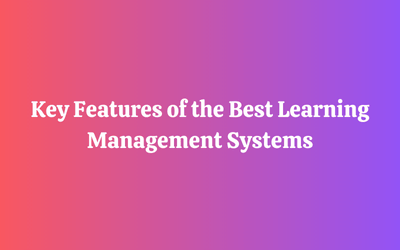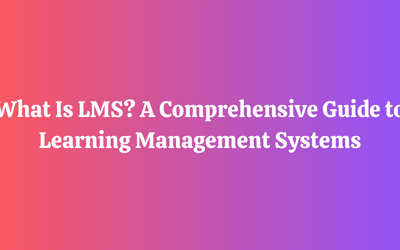LMS vs MOOC – Which One Is Right for Your Organization?
L&D professionals face a critical decision when selecting the right platform for their company’s learning and development initiatives. Two prominent options in the digital learning landscape are Learning Management Systems (LMS) and Massive Open Online Courses (MOOCs). While both offer valuable benefits for corporate training, they serve distinct purposes and cater to different organizational needs. Understanding the key differences between LMS and MOOC solutions is crucial for L&D leaders as they strive to align their strategies with company objectives and maximize the impact of their training programs.
An LMS, or Learning Management System, acts as the backbone for course delivery and management. It helps organizations store courses, track progress, and manage learner interactions efficiently. On the other hand, MOOCs—Massive Open Online Courses—offer a more flexible approach to learning by providing content-rich experiences accessible to large audiences.
In today’s rapid business environment, choosing between an LMS and a MOOC depends on your specific needs. Whether you aim to deliver structured training programs or engage learners at scale with diverse content options understanding their unique strengths will guide you in making informed decisions that align with your educational goals.
Understanding LMS and MOOC
An LMS, or Learning Management System, acts as a centralized platform for hosting and managing courses. It’s used to deliver, track, and manage educational content efficiently. Organizations leverage LMSs to help structured online learning environments with comprehensive administrative capabilities. This makes it ideal for traditional online education and corporate training programs where tracking progress is essential.
MOOCs, or Massive Open Online Courses, offer open-access courses designed for large-scale participation. Unlike typical LMS-hosted courses, MOOCs don’t require enrollment restrictions and are accessible to anyone with an internet connection. They focus on delivering flexible educational experiences that accommodate thousands of learners simultaneously. With their extensive reach and adaptability in content delivery formats like videos and forums, MOOCs complement conventional education by offering additional opportunities for knowledge acquisition.
LMSs often serve as the backbone supporting MOOCs by providing infrastructure for course management while ensuring seamless learner interactions. The integration of both systems allows educators to blend formal instruction with expansive learning opportunities effectively.
Understanding the distinction between a Learning Management System (LMS) and a Massive Open Online Course (MOOC) is essential for anyone navigating the online education landscape. An LMS, like Stratbeans Learning Management System, emphasizes structured learning and administrative control, offering features such as progress tracking, assessments, and tailored learning paths for organizations looking to cultivate specific skills within their workforce. Conversely, MOOCs are characterized by their open-access format, allowing a vast number of participants to engage with course materials from various educators worldwide, often without the need for formal enrollment or prerequisites. While MOOCs promote self-directed learning and accessibility, an LMS provides the structured support necessary for effective skill development and performance monitoring. By grasping these differences, educators and organizations can better determine the most effective approach to meeting their training objectives.
Key Differences Between LMS and MOOC

An LMS serves as a centralized platform that not only delivers educational content but also tracks and manages employee progress, making it a powerful tool for structured corporate learning. As a CHRO or L&D leader, leveraging an LMS allows your organization to:
Content Delivery
LMS platforms enable instructors to create, manage, and deliver courses tailored to institutional requirements. You find features like forums, quizzes, assignments, and grading tools that support customized content delivery. On the other hand, MOOCs provide structured course modules accessible through various online platforms such as Coursera or edX. They focus on a broad audience with pre-designed content including videos and tutorials.
Learning Formats
With an LMS, you experience a blend of synchronous and asynchronous learning modes suitable for formal education settings. This flexibility supports blended learning environments by combining in-person sessions with digital materials. MOOCs emphasize self-paced learning where content is organized weekly or modularly for independent study.
Accessibility and Interaction
An LMS offers controlled access primarily within institutions or organizations allowing detailed tracking of student progress. Interaction often occurs via integrated communication tools within the platform itself. Conversely, MOOCs are open-access courses reaching vast numbers of learners worldwide without enrollment restrictions fostering global interaction through forums or discussion boards available on host platforms.
Pros and Cons of LMS
Pros of LMS
- Comprehensive Management: An LMS provides centralized management for courses, including enrollment and content delivery. It tracks performance effectively, offering a structured learning environment.
- Customization: You can customize an LMS to fit your organization’s specific needs. This includes branding elements, diverse content options, and tailored user roles.
- Scalability: Easily scale the platform up or down based on your organization’s requirements. Cloud hosting supports large user bases efficiently.
- Cost: Implementing an LMS can involve significant expenses for setup and ongoing maintenance. It’s a factor to consider when budgeting for online education solutions.
- Complexity: The system’s comprehensive features might be overwhelming without proper training or technical support. It’s crucial to ensure that users understand how to navigate the platform.
- Limited Flexibility for Global Access: While effective within institutions, an LMS may not offer the same open-access flexibility as MOOCs do for global interaction.
Cons of LMS
- Initial Cost Consideration: Implementing an LMS often requires a significant upfront investment in software and hardware infrastructure. While potentially beneficial in the long run, this initial cost can be a barrier for some organizations.
- Learning Curve for Users: The feature-rich nature of many LMS platforms can lead to a steeper learning curve for both administrators and learners. This complexity may initially reduce user engagement if not addressed with proper training and support.
- Structured Format Limitations: LMS platforms typically cater to formal, structured learning environments. This can sometimes limit flexibility for organizations seeking to implement more dynamic or informal learning approaches.
- Restricted Access: Unlike MOOCs, LMS platforms are usually confined within organizational boundaries. While this ensures a focused learning environment, it can limit opportunities for global collaboration and broader knowledge sharing.
- Customization Complexities: Although LMS platforms offer customization options, tailoring the system to specific organizational needs can be challenging. This process often requires technical expertise or additional resources, which may not be readily available to all organizations.
- Scaling Challenges: While LMS platforms can accommodate growth, scaling them for very large organizations or extensive user bases can become complex. This may require additional resources and careful management to maintain optimal performance as the system expands.
Pros and Cons of MOOC
Pros of MOOC
- Open Access: MOOCs offer open access to quality education from top universities and institutions. You can enroll in courses without prerequisites, making them accessible to anyone interested.
- Affordability: Most MOOCs are free or available at a low cost, so providing a highly affordable option for learning new skills or exploring different subjects.
- Scalability: With the capacity to teach over 100,000 students simultaneously, MOOCs provide an unparalleled opportunity for global reach and exposure for both educators and learners.
- Flexibility: Courses are self-paced, allowing you to learn according to your schedule without the constraints of set start and end dates.
- Diverse Topics: A wide range of topics is available on MOOC platforms, offering opportunities to investigate into various areas of study beyond traditional curricula.
- Global Exposure: By participating in MOOCs, you gain insights from peers worldwide, enhancing knowledge-sharing and pedagogical techniques.
Cons of MOOC
- Lack of Personalization: Due to their massive scale, MOOCs can’t provide personalized attention or tailored courseware that might be offered in smaller class settings.
- Tracking Challenges: Monitoring student progress can be difficult with large numbers of participants; keeping track of assignments and engagement may prove challenging.
- Accessibility Issues: Learners with disabilities or poor internet connections may face challenges accessing course content effectively.
- Language Barriers: While English is common in many courses, language differences can hinder understanding for non-native speakers without adequate translation options.
- No Formal Accreditation: Often lacking formal accreditation from educational institutions means that while they offer valuable knowledge acquisition opportunities, they don’t typically contribute toward degree credits at universities.
Choosing the Right Option for Your Organization

When selecting between an LMS and a MOOC, consider your organization’s educational goals. If structured training and detailed progress tracking are priorities, an LMS offers comprehensive course management. It supports features like quizzes and forums that enhance learning experiences while maintaining control over access.
For organizations aiming to reach a broader audience with flexible content delivery, MOOCs provide scalable solutions. They enable open-access learning on platforms like Coursera or edX, making them ideal if global interaction and diverse topics are desired.
Assess scalability needs by evaluating learner volume expectations. An LMS suits smaller groups needing personalized education paths, whereas MOOCs handle thousands of participants simultaneously without enrollment caps.
Consider budget constraints when choosing the platform. An LMS involves setup and maintenance costs but provides tailored courses aligning with organizational objectives. Conversely, MOOCs offer cost-effective access to pre-designed content but may lack customization options.
Evaluate accessibility requirements based on target learners’ geographical locations and internet connectivity levels. An LMS ensures controlled access within institutions; but, MOOCs help global engagement through online courses accessible worldwide.
Determine the importance of accreditation in your decision-making process. If formal recognition of skills is necessary for learners’ career advancement, an LMS might be preferable due to its structured format supporting credentialed training programs.
Blending LMS and MOOCs for a Holistic Learning Strategy:
For optimal workforce development, a combination of LMS and MOOCs offers the best of both worlds. By utilizing an LMS for structured, goal-oriented training and incorporating MOOCs for expansive, self-driven learning, companies can:
Maximize Impact on Talent Development: Track the impact of both formal and informal learning, providing data-driven insights to HR and L&D teams for better decision-making on promotions, skills development, and future workforce needs.
Foster a Culture of Learning: Create a hybrid learning environment where employees have access to both formal, tracked training (via LMS) and open, exploratory learning (via MOOCs).
Ensure Skills Alignment: Use LMS tools to align MOOC offerings with the company’s strategic goals, providing employees with guided learning while still allowing flexibility.

Final Thought
In conclusion, as a CHRO or L&D head, recognizing the complementary nature of LMS and MOOCs can empower your organization to build a more dynamic, adaptable, and skilled workforce, while ensuring alignment with broader organizational goals. By strategically combining both platforms, you can cultivate a learning culture that drives employee engagement, innovation, and sustained business growth.
Exploring the world of online learning requires a clear understanding of your specific goals and needs. Whether you lean towards an LMS for its structured approach and detailed tracking or opt for MOOCs to engage a wider audience with flexible content, it’s essential to weigh the pros and cons of each. Consider factors like scalability, budget, accessibility, and accreditation when making your choice. A strategic blend of both platforms might offer the ideal solution, ensuring that you harness the strengths of each to meet your educational objectives effectively.
Our News
- AI
- Animations
- Articulate
- Articulate 360
- Articulate Engage
- Articulate Live
- Articulate Presenter
- Articulate Quizmaker
- Articulate Replay
- Articulate Review
- Articulate Storyline
- Articulate Storyline 3
- Articulate Studio
- bite sized learning
- Characters
- Content Library
- Corporate Communication
- E-Learning
- e-Learning Authoring Tools
- Employee Engagement
- Game-Based Learning
- Gamification
- Gamiflexer
- Go Sales
- Healthcare
- Instructional Design
- Interactivity
- Knowledge Transfer
- L&D Trends
- Learning
- Learning & Development
- Learning Experience platform
- Learning Management System
- LMS
- LXP
- Microlearning
- mLearning
- Mobile Learning
- Nugget Learning
- Online Training
- Peek
- Performance Support
- Preso
- Quiz and Assessment Platform
- Replay 360
- Rise
- SCORM
- Screen Capture
- Software
- Storyline 360
- Studio 360
- Training Management
- Trainings
- Uncategorized




